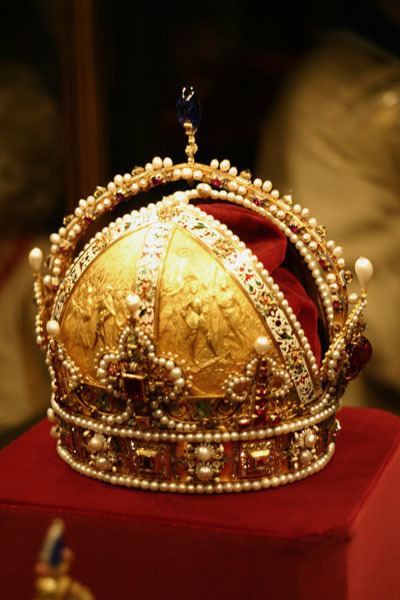 | ||
A half-arch is the piece of gold, silver or platinum, usually decorated with jewels, that links the circlet (circular base) of a hoop crown to the monde at the top of the crown.
Contents
British tradition of 4 half-arches
In the image of the Crown of Queen Elizabeth (1938), there are four half-arches, reflecting the examples of St. Edward's Crown, the State Crown of George I, the Coronation Crown of George IV and the Imperial State Crowns of Queen Victoria (1838) and George VI (1937).
Similarly other consort crowns of queens consort Mary of Modena and Adelaide of Saxe-Meiningen, the Crown of Mary of Modena and the Crown of Queen Adelaide, were made up of four half-arches, following British tradition.
The only example of a crown of a reigning British monarch possessing more than four half-arches is the Imperial Crown of India, made for King George V as Emperor of India to wear at the Delhi Durbar of 1911, and which had eight half-arches.
Crown of the Prince of Wales's 1 arch
The three crowns in existence of the Prince of Wales, the Heir Apparent to the British throne, all have one full arch, with a globe centred on the single arch rather than being the element to which each arch separately is joined, following an instruction laid down by King Charles II in 1677. Unlike the princely crowns of 1902 and 1969 however, where the single arch rises, in the Crown of Frederick, Prince of Wales (1728) the single arch dips in the centre, with the globe located in the centre of the dip.
European tradition of 8 half-arches
In contrast many European crowns traditionally contained many more, as did some other British consort crowns. For example, The crowns of two 20th century British Queens consort, the Crown of Queen Alexandra (1902) and the Crown of Queen Mary (1911), reflecting their origins as European princesses from Denmark and Germany respectively, each had eight half-arches. In addition, the British Imperial Crown of India was designed with eight half-arches to indicate the British monarch's claim to imperial title in India.
The Crown of Louis XV of France (1722), reflecting the European norm, has eight half-arches.
Shape of arch
Different crowns possess different shaped half arches. In some crowns, the half-arches dip down at the centre of the crown where they meet the globe. The most widely recognized example of this is St. Edward's Crown, the British coronation crown, while in others, such as Queen Elizabeth's consort crown, all four half-arches rise at a somewhat right angle, with no central dip.
However, in the case of the State Crown of George I, while the crown as originally designed had dipping arches, they were pulled up to a right angle for the coronation of King George II and have remained in that position.
Imperial Crown
In some crowns, such as the British Imperial State Crown, the half-arches are detachable, allowing the crown to be worn as a circlet. Alexandra of Denmark, Mary of Teck and Elizabeth Bowes-Lyon (British queens consort Alexandra, Mary and Elizabeth) all at various stages wore their own crowns as circlets, particularly after the deaths of the husbands, when one of their children was on the throne and they were the Queen Mother.
Velvet inlay
Where a crown possesses arches or half-arches, the circlet of the crown below the arches or half-arches are usually filled with velvet or other cloth, or with a jewelled metal cap. Different states and different crowns may possess different coloured cloth inlays.
The most widely used colours for cloth infils are purple, as in the Crown of Queen Elizabeth and in St. Edward's Crown, and dark red, as in the Imperial Crown of Austria.
No arches
However, not all crowns possess arches. The Danish Crown of Christian IV that was used for the coronation of elected monarchs prior to the introduction of absolutism in 1660 has no covering at all but exists in circlet form, while the Papal Tiara rises as one solid silver (or in one occasion gold) unit. Nor are arches to be found on the Iron Crown of Lombardy, any of the Iranian Crown Jewels. The Russian coronation crown possesses two central half arches, with most of the rest of the crown covered in. A same feature occurs on the mediaeval Crown of Rudolf II used by the Austrian Empire in the 19th century.
